Paper Menu >>
Journal Menu >>
 Int. J. Communications, Network and System Sciences, 2010, 3, 855-862 doi:10.4236/ijcns.2010.311116 Published Online November 2010 (http://www.SciRP.org/journal/ijcns) Copyright © 2010 SciRes. IJCNS Extraction of Buried Signals in Noise: Correlated Processes Nourédine Yahya Bey Université François Rabela is, Faculté des Sciences et Techniques, Parc de Grandmont, France E-mail: nouredine.yahyabey@phys.univ-tours.fr Received March 26, 2010; revised June 12, 2010; accepted July 29 , 2010 Abstract In this paper, we propose a method for extraction of signals correlated with noise in which they are buried. The proposed extraction method uses no a-priori information on the buried signal and works independently of the nature of noise, correlated or not with the signal, colored or white, Gaussian or not, and locations of its spectral extent. Extraction of buried correlated signals is achieved without averaging in the time or frequency domain. Keywords: Extraction, Buried Signals, Spectral Analysis, Colored Noise, White Noise, Correlated Processes 1. Introduction Extraction of buried signals remains to date an important challenge for investigation purposes in different areas of science as underwater acoustics, wave propagation, transmission, astronomical observations, earth observa- tion, data mining, etc (see, for example, [1-4] and a number of references in [5,6]). Signals taken in ex- tremely poor conditions or corrupted by various natures of noise in different systems are encountered in practice. This noise addition correlated or not with the desired signal degrades significantly the quality of information. In some situations, the signal is totally buried by various sources of noise. The effect of noise can be reduced but at the expense of the bandwidth and/or resolution which is, in most cases, undesired. Over-sampling and multi-sampling techniques and their properties are well known by a long time and are applied in several applications where detail preservation under largely unpredictable noise statistics is mandatory (seismics, evoked potentials and so on). Such methods in some practical settings (images with linear patterns, for example) can remove noise without significantly impacting the desired signal. Multi-channel and multi-dimensional signals have a lot of features to be exploited. It is crucial to notice that, in fact, these features are not suited to buried signals. Moreover, no a-priori informa- tion on the buried signal and the nature of noise with which it is correlated, is known. Notice also that by bur- ied signals, we mean signals defined for low or extreme low signal-to-noise ratio and the terms extraction of signals buried in noise, mean extraction of clean spec- tra of buried signals in noise. We proposed in [5,6] two non-parametric and equivalent extraction methods of buried signals assumed uncorrelated with noise. These equivalent methods are called respectively “modified frequency extent denoising (MFED)” and “constant frequency extent denoising (CFED)”. Here, the frequency extent is the interval [0, ] e f where e f is the sampling frequency of the bur- ied continuous-time signal to be extracted. The first pro- cedure (MFED) is based on modifying the sampling fre- quency and the second one (CFED) is suited to a collec- tion of available sample noisy processes. On the other hand, extraction of buried signals corre- lated with noise is of questionable interest (see, for ex- ample, [7-11] in different areas of science). In this work, we extend results of the aforementioned extraction method, CFED, to the presence of noise correlated with buried signals, maybe non-Gaussian, which is a fact and an issue. Notice that CFED extraction method is chosen for its implementation simplicity. Advantages of pro- posed extraction of buried signals are: 1) no a-priori information on the buried signal is used, 2) extraction works without averaging or smoothing in the time or frequency domain, 3) extraction is achieved independently of the nature of noise, colored or white, Gaussian or not, correlated or not with the signal, and locations of its spectral extent and, 4) straightforward extraction of signals buried in cor- 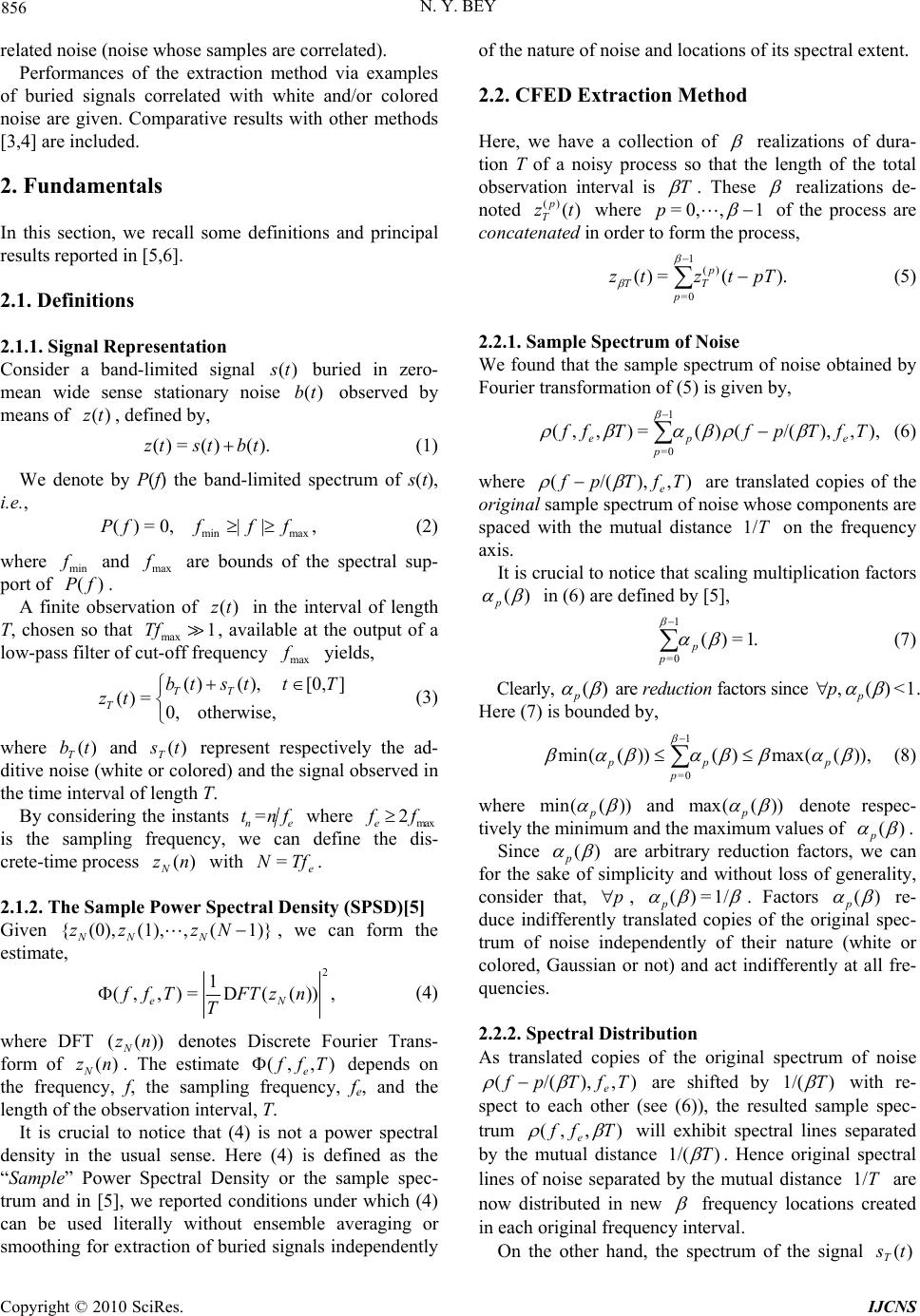 856 N. Y. BEY related noise (noise whose samples are correlated). Performances of the extraction method via examples of buried signals correlated with white and/or colored noise are given. Comparative results with other methods [3,4] are included. 2. Fundamentals In this section, we recall some definitions and principal results reported in [5,6]. 2.1. Definitions 2.1.1. Signal Representation Consider a band-limited signal buried in zero- mean wide sense stationary noise observed by means of , defined by, )(tsb)(t )(tz .)()(=)( tbtstz (1) We denote by P(f) the band-limited spectrum of s(t), i.e., min max ()=0,| |,Pfff f (2) where min f and max f are bounds of the spectral sup- port of . )( fP A finite observation of in the interval of length T, chosen so that max , available at the output of a low-pass filter of cut-off frequency )(tz 1Tf max f yields, ()(),[0,] ()= 0, otherwise, TT T bt sttT zt (3) where and represent respectively the ad- ditive noise (white or colored) and the signal observed in the time interval of length T. )(tbT)(tsT By considering the instants = ne where max is the sampling frequency, we can define the dis- crete-time process with . tnf2 e ff )(nzNe TfN = 2.1.2. The Sample Power Spectral Density (SPSD)[5] Given 1)}(,(1),(0),{ NzzzNNN, we can form the estimate, 2 1 (, ,)=D(()), eN ffTFTz n T (4) where DFT denotes Discrete Fourier Trans- form of . The estimate depends on the frequency, f, the sampling frequency, fe, and the length of the observation interval, T. ))(( nzN )n(zN),,( Tff e It is crucial to notice that (4) is not a power spectral density in the usual sense. Here (4) is defined as the “Sample” Power Spectral Density or the sample spec- trum and in [5], we reported conditions under which (4) can be used literally without ensemble averaging or smoothing for extraction of buried signals independently of the nature of noise and locations of its spectral extent. 2.2. CFED Extraction Method Here, we have a collection of realizations of dura- tion T of a noisy process so that the length of the total observation interval is T . These realizations de- noted where )( )( tz p T1, 0,= p of the process are concatenated in order to form the process, . (5) )(=)( )( 1 0= pTtztz p T p T 2.2.1. Sample Spectrum of Noise We found that the sample spectrum of noise obtained by Fourier transformation of (5) is given by, ,),),/(()(=),,( 1 0= TfTpfTff ep p e (6) where ),),/(( TfTpf e are translated copies of the original sample spectrum of noise whose components are spaced with the mutual distance on the frequency axis. T1/ It is crucial to notice that scaling multiplication factors )( p in (6) are defined by [5], .1=)( 1 0= p p (7) Clearly, )( p are reduction factors since 1<)(, p p. Here (7) is bounded by, 1 =0 min(( ))( )max(()), pp p p (8) where min(()) p and max(( )) p denote respec- tively the minimum and the maximum values of )( p. Since )( p are arbitrary reduction factors, we can for the sake of simplicity and without loss of generality, consider that, p , 1/=)( p. Factors )( p re- duce indifferently translated copies of the original spec- trum of noise independently of their nature (white or colored, Gaussian or not) and act indifferently at all fre- quencies. 2.2.2. Spectral Distribution As translated copies of the original spectrum of noise ),),/(( TfTpf e are shifted by )1/( T with re- spect to each other (see (6)), the resulted sample spec- trum ),,( Tff e will exhibit spectral lines separated by the mutual distance )1/( T . Hence original spectral lines of noise separated by the mutual distance are now distributed in new T1/ frequency locations created in each original frequency interval. On the other hand, the spectrum of the signal )(tsT Copyright © 2010 SciRes. IJCNS  N. Y. BEY 857 as given by the transformation of concatenated realiza- tions (5), is specified by ),,( Tff e . Since zeros are distributed in frequency locations created in each interval of length (see [5]) then, T1/ ,ff .)(,,(=) TffT e , e (9) 2.2.3. Extraction Properties Extraction of the sample spectrum of the buried signal is obtained by decimation. This decimation by the factor is applied in the frequency domain to the Fourier transformation of (5), i.e., ,),,[ TD e ,(=)] ffT D ,( f fe (10) where represents the decimation by ][ D applied to . The signal-to-noise ratio of the decimated spec- trum written as a function of the signal-to-noise ratio of the original spectrum is given by, = (11) We have shown in [5] that increasing (the number of collected sample processes) increases the signal-to- noise ratio of the original noisy spectrum e. Moreover, the variance of extracted sample spectral es- timates tends to zero as ),Tf,( f increases, i.e., .)],,([ 1 =)]([ 2TffVarVar eD ,T = ,ff e )(t T (12) 3. Buried Correlated Processes In [5,6], we assumed that the signal and additive noise, independently of its nature, are uncorrelated. In this sec- tion, we introduce correlation between the signal and noise in which it is buried by setting, ,)())()((thtnts TT (13) where represents the transfer function of a filtering system whose input is the stationary process )(th )(tns TT )(t and its output is the )(t T . Here the symbol denotes the convolution. Let us assume that we have sample processes. By concatenating these realizations, we form the process of duration T , .)( 1 0= pTt T p =)(t T (14) We propose hereafter to find the sample spectrum of (14). 3.1. Expression of the CFED Sample Spectrum Let be the Fourier transform of the impulse response of the filter . By using (14), the sample spectrum ),,( TffH e )(th ),,( Tff e yielded by (4) is composed of respectively the filtered sample spectrum of noise and the filtered sample spectrum of the signal defined by, ,),,(|),,(( 2TffTff ee =|),, HTff e =|),, HTff e and, ,),,(|),,((2TffPTff ee and the cross-products of their amplitude spectra. This means that the sample power spectrum ),,( Tffe as defined by (4) is given by, ,),,(),,( ),,(),,( ),,(),,( * * TffTff TffTff TffTff ee ee ee (=),, S S Tff e ),,( *Tff e )()( thtsT (15) where and are amplitude spectra of and . Here denote the complex conjugate of S),,( *Tffe )()( thtbT* x x . 3.2. Decimated CFED Sample Spectrum The decimated N-point sample spectrum applied to )T,,( ff e , as depicted by (15), yields, ,)],,(),, ),,(),,([ )],,([)],,(,([ * * TffTff TffTffS TffDTfffD ee ee ee ( [=)], S D DTfe ][ (16) where D is the -decimation applied to . Here, it is crucial to notice that our aim is to find the optimal form under which expression of the CFED sam- ple spectrum is written only as a function of the sample spectrum of the signal and noise independently of any correlation between the signal and noise and without averaging in the time or frequency domain. Since the sample spectra of the signal and noise are given by, [(,, [(,, Df Df )]=(,,) 1 )]=(,,), ee ee fT ffT fT ffT (17) then (16) becomes, * * 1 [(,, )]=( fT ,,)(,, ) [(,,)(,,)] [(,,)(,,)]. eee ee ee DfffTffT DSffTff T DSffTff T (18) Now, let us write the cross-products as a function of their Fourier coefficients. Let k be the Fourier coeffi- cient of the amplitude spectrum e of the sig- nal and let k ),,( TffS be the Fourier coefficient of the ampli- tude noise spectrum ),, Tff e ( . As, Copyright © 2010 SciRes. IJCNS 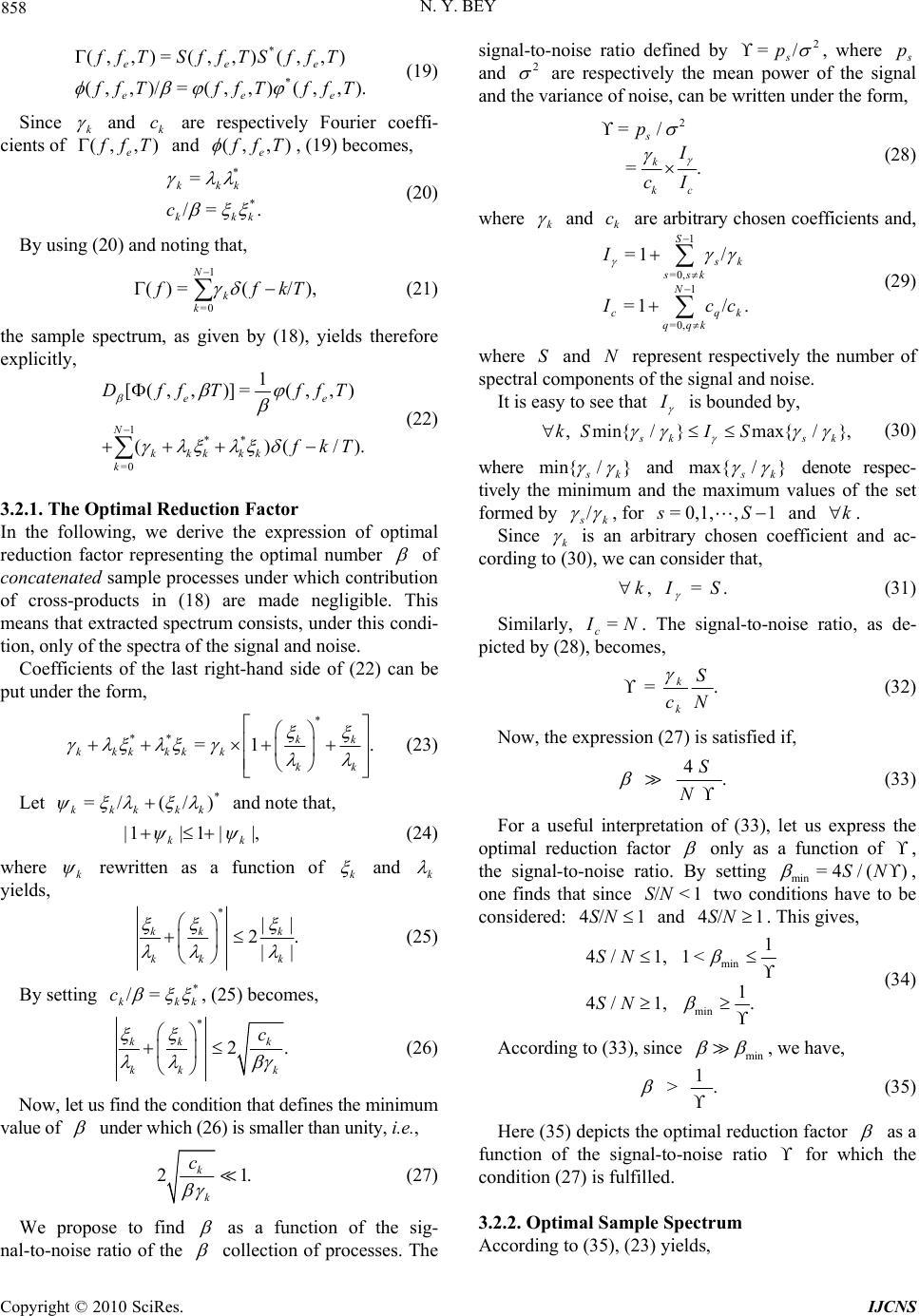 858 N. Y. BEY .),,(),,(=)/,,( ),,(),,(=),,( * * TffTffTff TffSTffSTff eee eee (19) Since k and are respectively Fourier coeffi- cients of and k c )T,, ff e (),,( Tff e , (19) becomes, .=/ = * * kkk kkk c (20) By using (20) and noting that, ,)/(=)( 1 0= Tkff k N k (21) the sample spectrum, as given by (18), yields therefore explicitly, 1** =0 1 [(,, )]=(,,) ()( ee N kkkkk k DffT ffT fkT /). (22) 3.2.1. The Optimal Reduction Factor In the following, we derive the expression of optimal reduction factor representing the optimal number of concatenated sample processes under which contribution of cross-products in (18) are made negligible. This means that extracted spectrum consists, under this condi- tion, only of the spectra of the signal and noise. Coefficients of the last right-hand side of (22) can be put under the form, * ** =1 kk kkkkk kkk . (23) Let and note that, * )/(/= kkkkk ,||1|1| kk (24) where k rewritten as a function of k and k yields, *|| 2 || kk k kk k . (25) By setting , (25) becomes, * =/kkk c * 2 kk k kk k c . (26) Now, let us find the condition that defines the minimum value of under which (26) is smaller than unity, i.e., 2 k k c 1. (27) We propose to find as a function of the sig- nal-to-noise ratio of the collection of processes. The signal-to-noise ratio defined by , where s and are respectively the mean power of the signal and the variance of noise, can be written under the form, 2 /= s pp 2 2 =/ =. s k kc p I cI (28) where k and are arbitrary chosen coefficients and, k c . k k max{/ s S /1= /1= 1 0,= 1 0,= q N kqq c s S kss ccI I (29) where and represent respectively the number of spectral components of the signal and noise. S N It is easy to see that is bounded by, I ,min{/} }, sk k kS I (30) where min{ /} s k and max{ /} s k denote respec- tively the minimum and the maximum values of the set formed by ks /, for and 1,S0,1,=sk . Since k is an arbitrary chosen coefficient and ac- cording to (30), we can consider that, .=, SIk (31) Similarly, . The signal-to-noise ratio, as de- picted by (28), becomes, NIc= =. k k S cN (32) Now, the expression (27) is satisfied if, 4. S N (33) For a useful interpretation of (33), let us express the optimal reduction factor only as a function of , the signal-to-noise ratio. By setting min =4 /(SN) , one finds that since two conditions have to be considered: 1</NS 1/4 NS and . This gives, 1/NS4 min min 1 4/ 1,1< 1 4/ 1,. SN SN (34) According to (33), since min , we have, 1 > . (35) Here (35) depicts the optimal reduction factor as a function of the signal-to-noise ratio for which the condition (27) is fulfilled. 3.2.2. Optimal Sample Spectrum According to (35), (23) yields, Copyright © 2010 SciRes. IJCNS 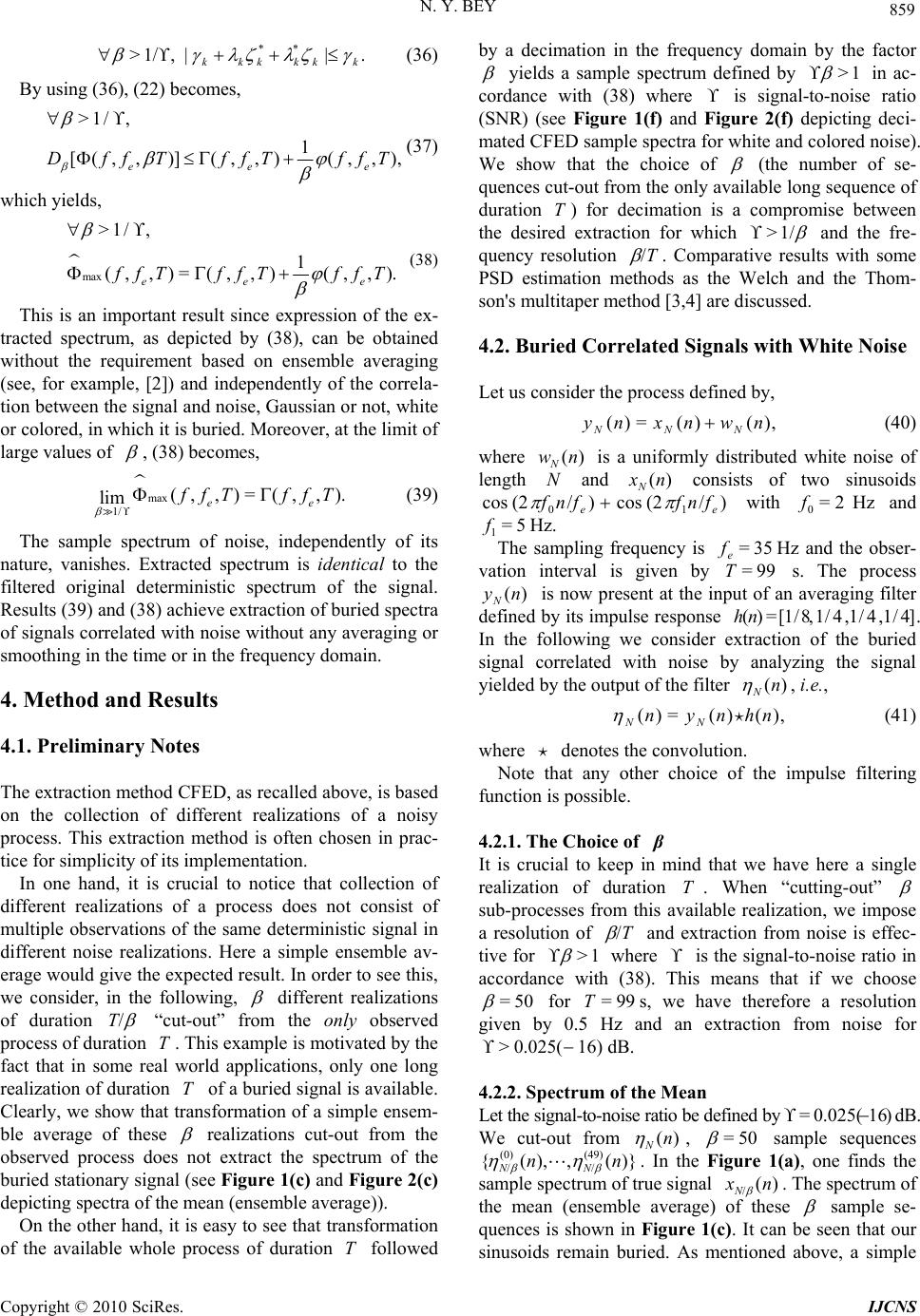 N. Y. BEY 859 .||,1/> ** kkkkkk (36) By using (36), (22) becomes, >1/, 1 [(, ,)](, ,)(, ,), ee DffTffTffT e (37) which yields, max >1/, 1 (, ,)=(, ,)(, ,). ee ffTffTffT e (38) This is an important result since expression of the ex- tracted spectrum, as depicted by (38), can be obtained without the requirement based on ensemble averaging (see, for example, [2]) and independently of the correla- tion between the signal and noise, Gaussian or not, white or colored, in which it is buried. Moreover, at the limit of large values of , (38) becomes, max 1/ (, ,)=(, ,). lim ee f fT ffT (39) The sample spectrum of noise, independently of its nature, vanishes. Extracted spectrum is identical to the filtered original deterministic spectrum of the signal. Results (39) and (38) achieve extraction of buried spectra of signals correlated with noise without any averaging or smoothing in the time or in the frequency domain. 4. Method and Results 4.1. Preliminary Notes The extraction method CFED, as recalled above, is based on the collection of different realizations of a noisy process. This extraction method is often chosen in prac- tice for simplicity of its implementation. In one hand, it is crucial to notice that collection of different realizations of a process does not consist of multiple observations of the same deterministic signal in different noise realizations. Here a simple ensemble av- erage would give the expected result. In order to see this, we consider, in the following, different realizations of duration /T “cut-out” from the only observed process of duration T . This example is motivated by the fact that in some real world applications, only one long realization of duration T of a buried signal is available. Clearly, we show that transformation of a simple ensem- ble average of these realizations cut-out from the observed process does not extract the spectrum of the buried stationary signal (see Figure 1(c) and Figure 2(c) depicting spectra of the mean (ensemble average)). On the other hand, it is easy to see that transformation of the available whole process of duration T followed by a decimation in the frequency domain by the factor yields a sample spectrum defined by 1> in ac- cordance with (38) where is signal-to-noise ratio (SNR) (see Figure 1(f) and Figure 2(f) depicting deci- mated CFED sample spectra for white and colored noise). We show that the choice of (the number of se- quences cut-out from the only available long sequence of duration ) for decimation is a compromise between the desired extraction for which T 1/> and the fre- quency resolution T/ . Comparative results with some PSD estimation methods as the Welch and the Thom- son's multitaper method [3,4] are discussed. 4.2. Buried Correlated Signals with White Noise Let us consider the process defined by, ,)n( N )(( nnyN=) xN (nxN (2cos w )/ e f (40) where is a uniformly distributed white noise of length and consists of two sinusoids )w ) e f (n N N / 0fn )f(2 1ncos with Hz and Hz. 2= 0 f 8,1/ 4 ,1/ 5= 1 f yN The sampling frequency is Hz and the obser- vation interval is given by s. The process is now present at the input of an averaging filter defined by its impulse response . In the following we consider extraction of the buried signal correlated with noise by analyzing the signal yielded by the output of the filter 35 99 ) =[1/ )(n N = e =T (hn f )(n 4,1/ 4] , i.e., ,)(n)h(n N =y)(n N (41) where denotes the convolution. Note that any other choice of the impulse filtering function is possible. 4.2.1. The Choice of β It is crucial to keep in mind that we have here a single realization of duration T. When “cutting-out” sub-processes from this available realization, we impose a resolution of T/ and extraction from noise is effec- tive for 1> where is the signal-to-noise ratio in accordance with (38). This means that if we choose 50= for s, we have therefore a resolution given by 0.5 Hz and an extraction from noise for 99=T 0.025(> 16) dB. 4.2.2. Spectrum of the Mean Let the signal-to-noise ratio be defined by )160.025(= dB. We cut-out from )(n N , 50= sample sequences . In the Figure 1(a), one finds the sample spectrum of true signal . The spectrum of the mean (ensemble average) of these )}(),( (49) / (0) /nn N ,{N )(n / xN sample se- quences is shown in Figure 1(c). It can be seen that our sinusoids remain buried. As mentioned above, a simple Copyright © 2010 SciRes. IJCNS 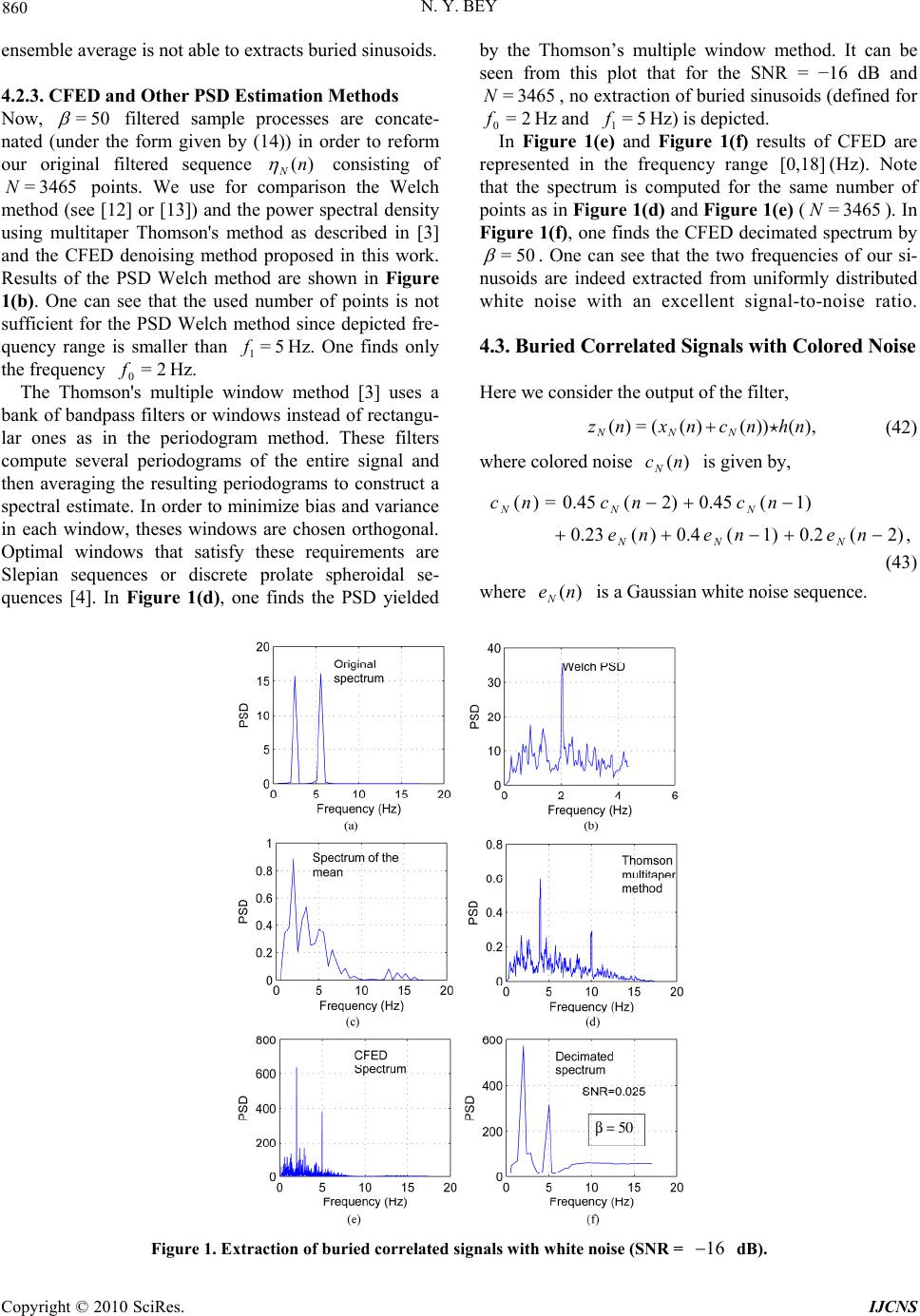 N. Y. BEY Copyright © 2010 SciRes. IJCNS 860 ensemble average is not able to extracts buried sinusoids. 4.2.3. CFED and Other PSD Estimation Methods Now, 50= filtered sample processes are concate- nated (under the form given by (14)) in order to reform our original filtered sequence )(n N consisting of points. We use for comparison the Welch method (see [12] or [13]) and the power spectral density using multitaper Thomson's method as described in [3] and the CFED denoising method proposed in this work. Results of the PSD Welch method are shown in Figure 1(b). One can see that the used number of points is not sufficient for the PSD Welch method since depicted fre- quency range is smaller than Hz. One finds only the frequency Hz. 3465=N 5= 1 f 2= 0 f The Thomson's multiple window method [3] uses a bank of bandpass filters or windows instead of rectangu- lar ones as in the periodogram method. These filters compute several periodograms of the entire signal and then averaging the resulting periodograms to construct a spectral estimate. In order to minimize bias and variance in each window, theses windows are chosen orthogonal. Optimal windows that satisfy these requirements are Slepian sequences or discrete prolate spheroidal se- quences [4]. In Figure 1(d), one finds the PSD yielded by the Thomson’s multiple window method. It can be seen from this plot that for the SNR = −16 dB and , no extraction of buried sinusoids (defined for Hz and Hz) is depicted. 3465=N 2= 0 f5= 1 f In Figure 1(e) and Figure 1(f) results of CFED are represented in the frequency range [0,18] (Hz). Note that the spectrum is computed for the same number of points as in Figure 1(d) and Figure 1(e) (). In Figure 1(f), one finds the CFED decimated spectrum by 3465=N 50= . One can see that the two frequencies of our si- nusoids are indeed extracted from uniformly distributed white noise with an excellent signal-to-noise ratio. 4.3. Buried Correlated Signals with Colored Noise Here we consider the output of the filter, ,)())()((=)( nhncnxnzNNN (42) where colored noise is given by, )(ncN ,2)(0.21)(0.4)(0.23 1)(0.452)(0.45=)( nenene ncncnc NNN NNN (43) where is a Gaussian white noise sequence. )(neN Figure 1. Extraction of buried correlated signals with white noise (SNR = dB). 16 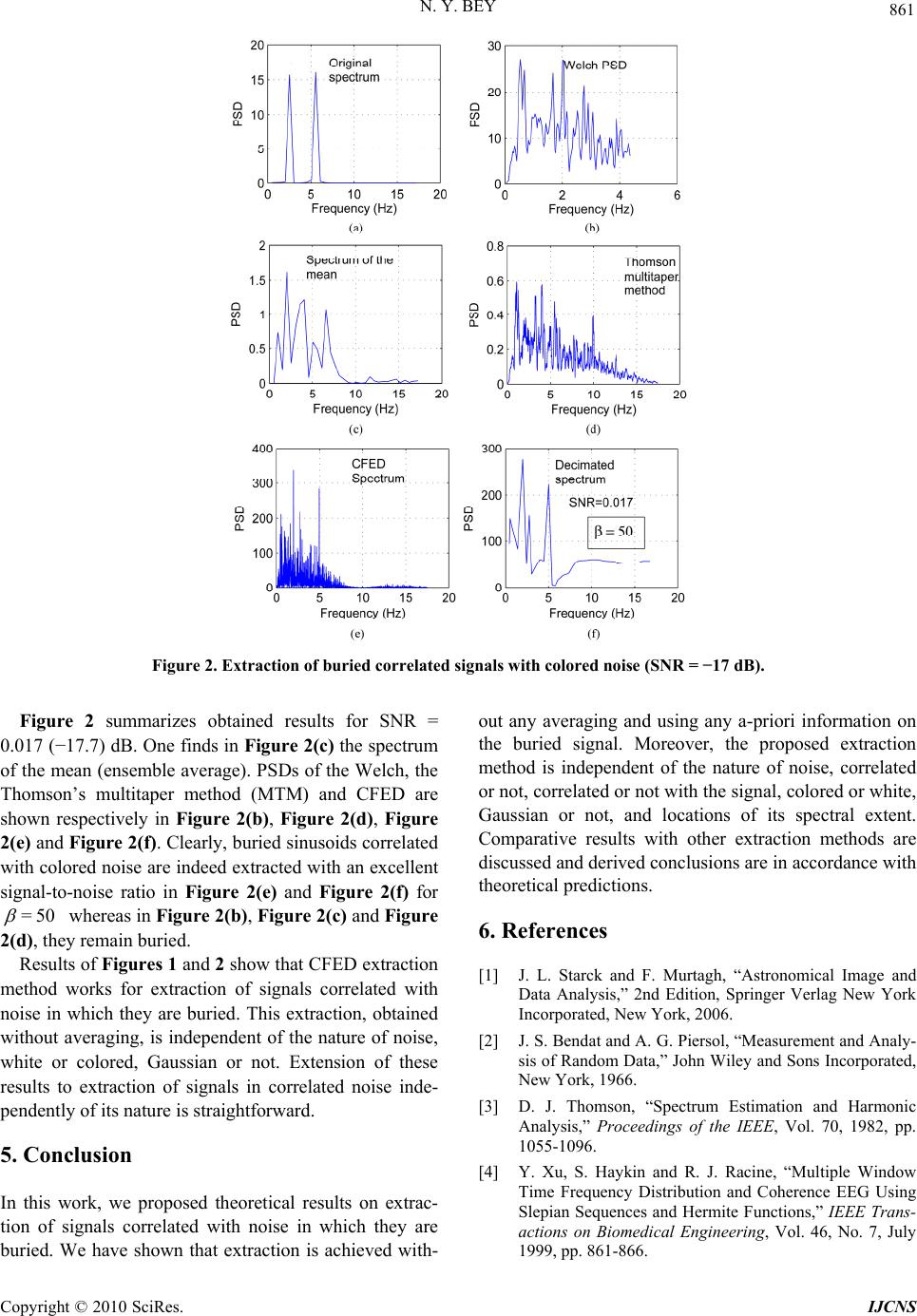 N. Y. BEY 861 Figure 2. Extraction of buried correlated signals with colored noise (SNR = −17 dB). Figure 2 summarizes obtained results for SNR = 0.017 (−17.7) dB. One finds in Figure 2(c) the spectrum of the mean (ensemble average). PSDs of the Welch, the Thomson’s multitaper method (MTM) and CFED are shown respectively in Figure 2(b), Figure 2(d), Figure 2(e) and Figure 2(f). Clearly, buried sinusoids correlated with colored noise are indeed extracted with an excellent signal-to-noise ratio in Figure 2(e) and Figure 2(f) for 50= whereas in Figure 2(b), Figure 2(c) and Figure 2(d), they remain buried. Results of Figures 1 and 2 show that CFED extraction method works for extraction of signals correlated with noise in which they are buried. This extraction, obtained without averaging, is independent of the nature of noise, white or colored, Gaussian or not. Extension of these results to extraction of signals in correlated noise inde- pendently of its nature is straightforward. 5. Conclusion In this work, we proposed theoretical results on extrac- tion of signals correlated with noise in which they are buried. We have shown that extraction is achieved with- out any averaging and using any a-priori information on the buried signal. Moreover, the proposed extraction method is independent of the nature of noise, correlated or not, correlated or not with the signal, colored or white, Gaussian or not, and locations of its spectral extent. Comparative results with other extraction methods are discussed and derived conclusions are in accordance with theoretical predictions. 6. References [1] J. L. Starck and F. Murtagh, “Astronomical Image and Data Analysis,” 2nd Edition, Springer Verlag New York Incorporated, New York, 2006. [2] J. S. Bendat and A. G. Piersol, “Measurement and Analy- sis of Random Data,” John Wiley and Sons Incorporated, New York, 1966. [3] D. J. Thomson, “Spectrum Estimation and Harmonic Analysis,” Proceedings of the IEEE, Vol. 70, 1982, pp. 1055-1096. [4] Y. Xu, S. Haykin and R. J. Racine, “Multiple Window Time Frequency Distribution and Coherence EEG Using Slepian Sequences and Hermite Functions,” IEEE Trans- actions on Biomedical Engineering, Vol. 46, No. 7, July 1999, pp. 861-866. Copyright © 2010 SciRes. IJCNS 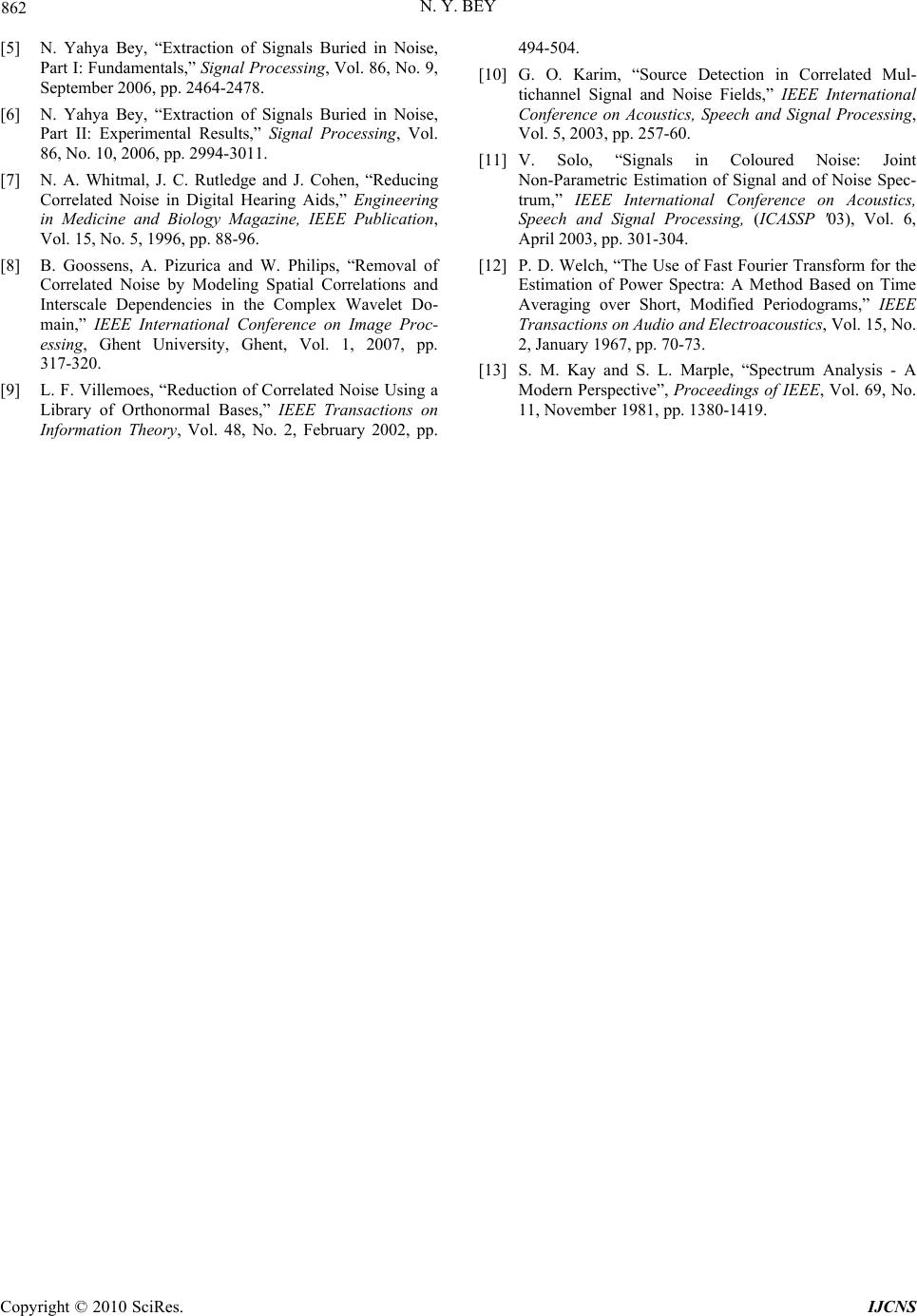 862 N. Y. BEY [5] N. Yahya Bey, “Extraction of Signals Buried in Noise, Part I: Fundamentals,” Signal Processing, Vol. 86, No. 9, September 2006, pp. 2464-2478. [6] N. Yahya Bey, “Extraction of Signals Buried in Noise, Part II: Experimental Results,” Signal Processing, Vol. 86, No. 10, 2006, pp. 2994-3011. [7] N. A. Whitmal, J. C. Rutledge and J. Cohen, “Reducing Correlated Noise in Digital Hearing Aids,” Engineering in Medicine and Biology Magazine, IEEE Publication, Vol. 15, No. 5, 1996, pp. 88-96. [8] B. Goossens, A. Pizurica and W. Philips, “Removal of Correlated Noise by Modeling Spatial Correlations and Interscale Dependencies in the Complex Wavelet Do- main,” IEEE International Conference on Image Proc- essing, Ghent University, Ghent, Vol. 1, 2007, pp. 317-320. [9] L. F. Villemoes, “Reduction of Correlated Noise Using a Library of Orthonormal Bases,” IEEE Transactions on Information Theory, Vol. 48, No. 2, February 2002, pp. 494-504. [10] G. O. Karim, “Source Detection in Correlated Mul- tichannel Signal and Noise Fields,” IEEE International Conference on Acoustics, Speech and Signal Processing, Vol. 5, 2003, pp. 257-60. [11] V. Solo, “Signals in Coloured Noise: Joint Non-Parametric Estimation of Signal and of Noise Spec- trum,” IEEE International Conference on Acoustics, Speech and Signal Processing, (ICASSP '03), Vol. 6, April 2003, pp. 301-304. [12] P. D. Welch, “The Use of Fast Fourier Transform for the Estimation of Power Spectra: A Method Based on Time Averaging over Short, Modified Periodograms,” IEEE Transactions on Audio and Electroacoustics, Vol. 15, No. 2, January 1967, pp. 70-73. [13] S. M. Kay and S. L. Marple, “Spectrum Analysis - A Modern Perspective”, Proceedings of IEEE, Vol. 69, No. 11, November 1981, pp. 1380-1419. Copyright © 2010 SciRes. IJCNS |

